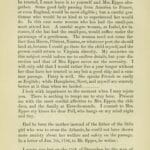Beverly Hemings, the eldest son of Sally Hemings and likely fathered by Thomas Jefferson, lived a life both privileged and precarious. Born into slavery at Monticello, Jefferson’s famed Virginia estate, Hemings navigated a complex world of freedom and constraint. While historical records are frustratingly scant, his story offers a glimpse into the vast, often untold narratives of African Americans during the antebellum period.
Leaving Monticello: A Step into the Unknown
At the age of 24, in 1822, Beverly Hemings vanished from documented history. His departure from Monticello remains shrouded in mystery, with historians debating whether he escaped or was granted freedom. Some scholars suggest that Jefferson, nearing the end of his life, may have quietly allowed Beverly to leave. Others posit that Beverly, driven by a yearning for self-determination, bravely fled, seeking a life beyond the confines of Monticello.
Whatever the circumstances, Beverly’s departure marked a pivotal moment. Stepping out from under the shadow of Monticello represented a bold assertion of agency, a decision to seize freedom and shape his own destiny. This act alone stands as a testament to his courage and resilience.
A Life Shrouded in Mystery: Piecing Together Fragments
Details of Beverly’s life after Monticello are frustratingly scarce, cobbled together from fragments of oral history and educated speculation. His brother, Madison Hemings, later shared that Beverly had successfully assumed a white identity, integrating seamlessly into society. He is said to have married into a well-regarded Maryland family, further obscuring his past.
The fact that Beverly felt compelled to make such a drastic choice underscores the harsh realities of the time. Racial barriers and deeply ingrained prejudices presented insurmountable obstacles for African Americans, even those of Hemings’ lineage. Passing as white, while a difficult and often painful decision, offered a path, however fraught, towards freedom and opportunity.
A Legacy of Courage and the Search for Identity
Beverly Hemings’ story transcends the narrative of a single man’s quest for freedom. It reflects the experiences of countless African Americans during an era defined by racial injustice. His decision to pass as white lays bare the complexities of racial identity in a society deeply divided along lines of color.
While much of his life remains shrouded in mystery, Beverly Hemings’ legacy lies in his courage to defy the expectations of his time. He dared to carve out a space for himself in a world determined to deny his very existence. His story, though incomplete, stands as a testament to the resilience of the human spirit and the enduring power of the human desire for freedom and self-determination.
What Happened to Beverly Hemings?
Beverly Hemings, the eldest son of Sally Hemings, disappears from historical records after 1822. Despite his connection to one of America’s most prominent figures, his life beyond Monticello remains an enigma. A skilled carpenter by trade, his existence outside the plantation walls is a mystery begging to be unraveled.
Several theories attempt to explain Beverly’s disappearance:
Passing into White Society: Some historians believe Beverly chose to live as a white man, a common practice during this era. By assuming a new identity, he could escape the pervasive racism and limitations imposed on African Americans.
Deliberate Obscurity: It’s possible that Beverly intentionally obscured his identity to protect himself and any family he may have created. Starting anew with a new name would have been a difficult but potentially necessary decision to ensure his safety and freedom.
Lost Records: The passage of time often leads to gaps in historical documentation. It’s possible that records of Beverly’s life simply haven’t been found yet, hidden away in an archive or private collection.
The lack of concrete evidence makes it impossible to definitively determine Beverly’s fate. However, uncovering his story requires a deeper dive into historical records, genealogical research, and a nuanced understanding of the societal pressures faced by biracial individuals in the early 19th century.
Are there any living descendants of Sally Hemings?
Yes, Sally Hemings’ descendants are very much a part of the American tapestry today. Primarily descended from her sons Eston and Madison Hemings, their family history offers a poignant example of the enduring legacy of slavery and the complexities of racial identity.
Interestingly, Eston and Madison’s descendants charted different paths. Eston, choosing to pass as white after leaving Monticello, has descendants who largely identify as white. Madison’s descendants, conversely, embraced their African American heritage.
Despite these divergent journeys, both sides of the family acknowledge their shared ancestry. They hold reunions, recognizing their connection to this significant historical narrative.
The Thomas Jefferson Foundation, which oversees Monticello, officially recognized the relationship between Jefferson and Hemings in 2000, solidifying what oral history had long maintained. This acknowledgement, coupled with DNA evidence confirming Jefferson’s paternity of at least six of Hemings’ children, has sparked essential conversations about the complex dynamics of power, race, and consent, particularly within the context of American slavery.
The story of Sally Hemings and her descendants serves as a powerful reminder of the enduring impact of the past on the present. It challenges us to confront difficult truths about our history and acknowledge the ways in which racial identity has been shaped and reshaped over time.
What Happened to Sally Hemings’ Children?
The lives of Sally Hemings’ children offer a window into the varied and often heartbreaking realities faced by those born into slavery, even within the household of a U.S. president. Each of their stories reflects the struggle for freedom and the pursuit of self-determination against a backdrop of profound injustice.
Here’s a glimpse into their fates:
Beverly Hemings (born 1798): As previously discussed, Beverly’s life after Monticello is largely unknown. Historical evidence suggests that he chose to pass as white, disappearing into society to escape the limitations imposed by his race.
Harriet Hemings (born 1801): Like her older brother, Harriet also chose to leave Monticello as a young woman, likely assuming a white identity. Her life after her departure remains a mystery.
Madison Hemings (born 1805): Granted freedom upon Jefferson’s death in 1826, Madison went on to become a respected violinist. In 1873, he bravely gave an interview confirming his paternity as Thomas Jefferson, a controversial statement at the time.
Eston Hemings (born 1808): Also freed after Jefferson’s passing, Eston chose a different path. He moved to Wisconsin, changed his surname to “Jefferson,” and lived as a white man.
The divergent paths chosen by Sally Hemings’ children reveal the multifaceted nature of navigating life as a biracial individual during this time period. Some, like Beverly and Harriet, sought to escape the constraints of their birth by embracing a white identity. Others, like Madison, navigated a world where their freedom remained tenuous, choosing to live openly as themselves. Eston’s story introduces another layer of complexity, highlighting the fluid nature of race and identity, often shaped by the pursuit of a better life.
Each of these individuals, shaped by their unique experiences, represents the larger struggle for dignity and self-determination within a system built on the exploitation of enslaved people. Their stories remind us that history is rarely simple; it’s a tapestry woven from threads of resilience, heartbreak, and the ongoing fight for equality.
For another captivating glimpse into history, we invite you to read about Beatrice Wood’s Titanic Discovery, a tale that unveils a tragic and often overlooked facet of the infamous ship’s legacy.















